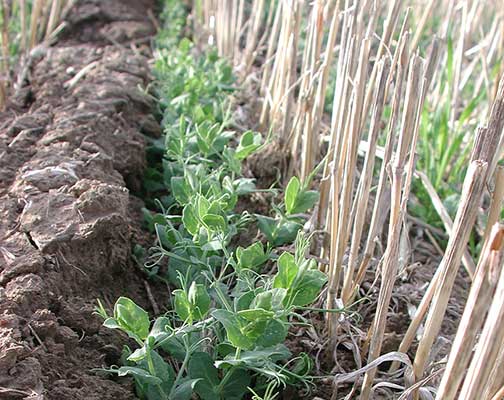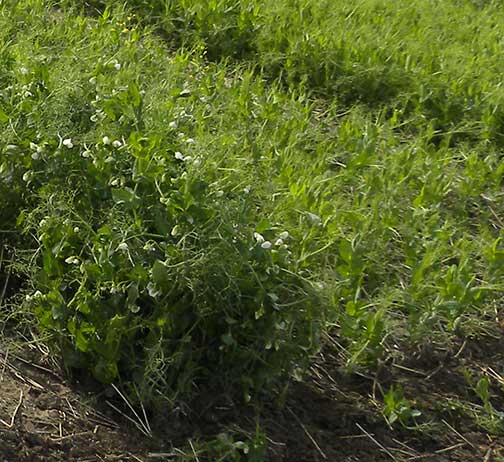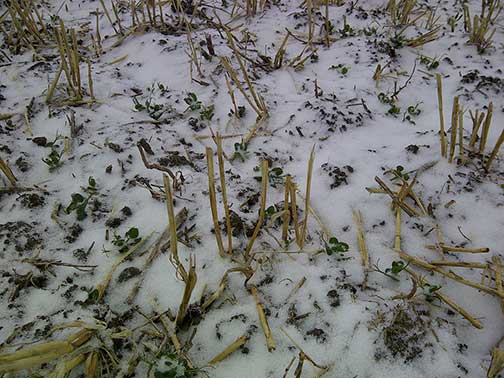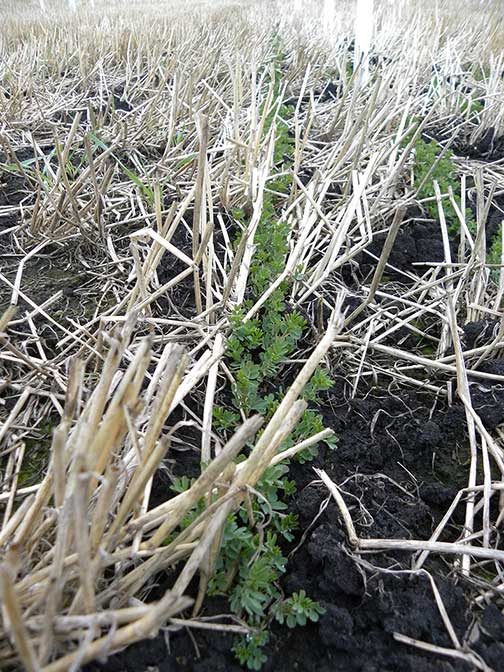| | Areas of adaptability | Winter pea | Winter lentil | Winter pea and lentil – markets
Winter pea and winter lentil can be profitable options to include in southern Alberta crop rotations.
When grown in the appropriate area using the proper variety and agronomic practices, winter pea and lentil can yield up to 39 per cent more than spring types, making it an agronomically and economically sound choice for growers.
Areas of Adaptability
Unlike winter cereals, winter pulses cannot be successfully grown in all areas of Alberta. Field studies conducted throughout south and central Alberta found that winter pea and winter lentil produced yields equal to or better than spring pea and lentil only in Lethbridge and Bow Island.
Due to harsh winter conditions, winter pea and lentil yielded less than 50 per cent of the spring types at Brooks and Lacombe. So although winter pea and lentil can survive at these locations, yields are reduced to the point where they are not an economically feasible option for growers.
Field studies near Edmonton found that winter pea and lentil had absolutely no survivability despite good snow cover.
Winter Pea
Variety Selection
Researchers found there are two winter pea varieties with sufficient winter hardiness for production in southern Alberta. These varieties are Specter and Windham, developed by Drs. Fred Muehlbauer and Kevin McPhee at Washington State University.
Specter is a semi-leafless, tall variety (100 cm vine length), with a yellow cotyledon that has a clear seed coat which is characterized by subtle mottling. Specter seed is small, 131 mg seed-1.
Windham is also a semi-leafless, yellow cotyledon variety with a clear seed coat that has subtle mottling. It is much shorter than Specter (57 cm vine length) and has a small seed size, 150 mg seed-1.
Planting dates
To maximize yields, winter pea should be seeded by the third week of September. Alberta studies found that winter pea yields were reduced by 15 per cent if seeding was delayed until late-September or early October.

Figure 1. Winter pea fall establishment.
Seeding rates
Alberta research found that increasing seeding rates from 75 to 113 plants m-2 had little or no effect on winter pea yield. Other studies found similar trends.
It is recommended that winter pea is seeded at 75 plants m-2 to achieve optimum yields, which is the same recommendation used for spring pea. Given the small seed size of winter pea relative to spring pea, it is essential that actual seeding rates be based on the 1,000 kernel weight of the seed that will be planted.

Figure 2. Winter pea flowering on left, spring pea on middle-right.
Survivability
Although a minimum plant stand is necessary to achieve high yields, winter pea survivability (spring plant density expressed as a per cent of target plant density) does not correlate well with yield. This factor may be attributed to winter pea varieties generally having a greater capacity for tillering compared with spring pea varieties. Yields greater than 2,000 kg ha-1 (30 bushels acre-1) were produced with winter pea survivability ranging from 25 to 83 per cent of the target.
High winter pea yields are highly dependent on both the spring plant stand and environmental conditions during the growing season. Alberta research suggests that acceptable winter pea yields can be achieved with at least 40 per cent winter pea survivability (30 plants m-2). If fields have less than 40 per cent winter pea survivability, they should be abandoned and re-seeded to another crop.
Flowering and disease
On average, winter pea cultivars flowered 16 days earlier than spring pea cultivars.
Winter pea trials conducted in Alberta had very little disease. However, it is important to remember that unlike spring pea varieties; these winter pea varieties do not have genetic resistance to powdery mildew.
In early spring, Asoschyta was observed more frequently on the winter pea cultivars than on the spring pea cultivars. Although Ascochyta tends to infect the winter pea varieties first, later in the growing season, infection rates between winter and spring pea varieties are negligible.
Yield and harvest
Although winter pea types flowered 16 days earlier than spring pea types, that situation does not translate into a two-week earlier harvest. Winter pea varieties were harvested only 1 week earlier than spring types, and that occurs only 50 per cent of the time. The other half of the time, winter peas matured at the same time as the spring pea varieties, regardless of the fall planting date.
At Lethbridge, winter pea yields were 39 per cent higher than spring pea yields, representing a 1,087 kg ha-1 (16 bushel acre-1) increase in yield. At Bow Island, yields of winter and spring pea varieties were the same.

Figure 3. Overwintering winter pea seedlings. (Photo: Jamie Purchinger of Farming Smarter)
Winter Lentil
Variety selection
Only one winter lentil variety, Morton, had sufficient winter hardiness for production in southern Alberta. Morton was developed by Drs. Fred Muehlbauer and Kevin McPhee at Washington State University. It has an upright growth habit, and plants are 31 cm tall. Morton seeds have a beige seed coat with a red cotyledon. Seeds are small with a seed weight of 33 mg seed-1.
Planting dates
To achieve maximum yields, winter lentil should be planted during the second and third weeks of September. While seeding can be completed in the first week of September, researchers occasionally observed a 10 to 12 per cent yield reduction.

Figure 4. Winter lentil fall establishment.
Seeding rates
If growers choose to seed in early September, higher seeding rates should be used as yields increased by 22 to 68 per cent as seeding rates increased from 110 to 220 plants m-2.
However, when seeding was completed in the second and third weeks of September, there was no increase in yield as seeding rate increased. Given that seeding is recommended in the second and third weeks of September, winter lentil can be seeded at 110 plants m-2, which is the same recommendation used for spring lentil.
Since winter lentil seed can be smaller than spring lentil seed, it is essential that actual seeding rates be based on the 1,000 kernel weight of the seed that will be planted.
Survivability
Like the trends observed with pea, lentil winter survivability did not strongly correlate with yield.
Yields greater than 2,000 kg ha-1 (1,784 lbs acre-1) were produced with winter lentil survivability ranging from 56 to 84 per cent. High yields are also highly dependent upon environmental conditions during the growing season.
Based on Alberta research, it is recommended that fields with less than 55 per cent (60 plants m-2) winter lentil survivability be abandoned and re-seeded to another crop.
Flowering and disease
Winter lentil tends to flower 11 days earlier than spring lentil.
Very little disease was found on winter lentils in Alberta field trials. There were low level infections of Ascochyta sp., Alternaria sp. and Fusarium sp.. Sclerotinia has been observed later in the growing season where the canopy was thick; however, it was not thought to affect yield.
Yield and harvest
Winter lentil planting date had no effect on harvest date. However, in approximately two out of every three years, the winter lentils were harvested eight days earlier than the spring lentils.
At Lethbridge and Bow Island, winter lentil yields were 15 to 39 per cent greater (430 to 1,521 kg ha-1; 384 to 1,357 bushels acre-1) than the spring lentil yields.
Winter Pea and Lentil – Markets
Winter pea varieties grown in the United States have been marketed as feed. However, cooking quality and seed compositional analysis have shown that there is no quality disadvantage associated with the winter types, and therefore, winter cultivars may be acceptable for human consumption markets.
Summary
Winter pea and winter lentil can be good options for producers in the Lethbridge and Bow Island areas of Alberta. When using a winter hardy variety such as Specter, Windham or Morton, yields were up to 39 per cent more than spring pea and lentil yields.
Winter pea should be seeded by the third week of September and winter lentil during the second and third weeks of September. Recommended seeding rates for winter pea and lentil are 75 and 110 plants m-2, respectively, which are the same as spring pea and lentil seeding rate recommendations.
Prepared by
Sheri Strydhorst, PhD
Research Scientist, Agronomy
Alberta Agriculture and Rural Development
More information
Contact Alberta Ag-Info Centre
Call toll free 310-FARM (3276)
Source: Agdex 142/20-2. April 2013.
|
|